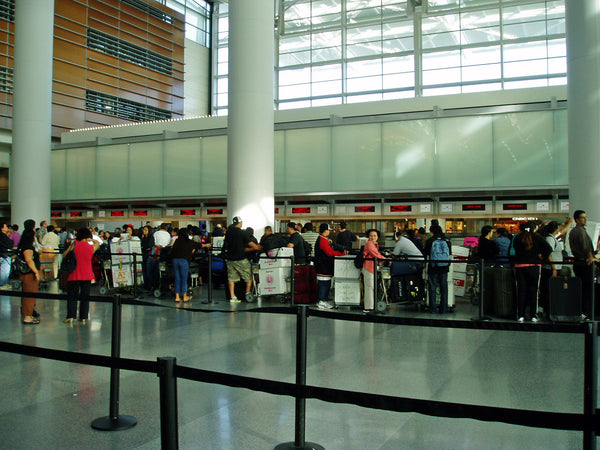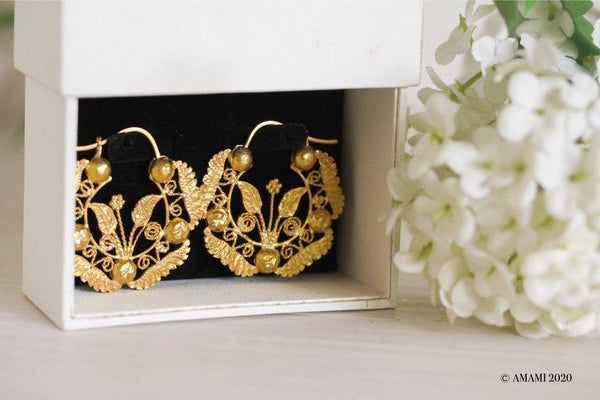Balikbayan, OFW, pasalubong—the Filipino language has so many words for those coming and going.
Between Ortigas Station and Cubao-Araneta Station of the MRT, the Philippine Overseas Employment Administration (POEA) building looms. Hordes of passengers pass by its curving facade everyday. As they walk down the streets of Metro Manila, flyers advertising work overseas flutter from electricity posts and littered walls. Or from recruiters’ outstretched fingers.
On TV, a commercial plays: a young spelling bee contestant is asked to spell remittance. the child answers by spelling the name of a popular remittance center.
In my family, a special part of Christmas, New Year, and birthdays are reserved for video calls to my grandparents on the East Coast of the United States. Calculating the twelve-hour time difference has become a reflex.
I live near the airport where the sound of planes taking off punctuate my hours. I admit: it’s become white noise to me.
For millions of Filipinos who have close family overseas, they’re reminded everyday of the physical distance from their loved ones.
The Philippine Statistics Authority estimates 2.3 million OFWs were deployed from the Philippines between April to September 2018. In this same period, OFWs sent a total of 235.9 billion Philippine Pesos (today, that’s 4.7 billion US Dollars) in remittances. This includes money sent home, cash brought back, and balikbayan boxes filled to the brim with everything you could imagine. A treasure-trove of riches containing whatever you might want, from chocolate to sneakers.

Departures: The Filipino Dream Overseas
For many Filipinos, working abroad is the dream. Whether you’re middle-class or low-income, it’s understood as the only viable option to escape poverty. Even if it takes you away from family and friends.
Earning in a stronger currency presents the opportunity to get a foot in the door to financial security. One you can hold open for the rest of your family to walk through. It’s a way to a comfortable (if not prosperous) life you couldn’t create otherwise in the Philippines.
However, the decision to leave home is never without its risks, troubles, and heartaches.
On the local news, too often we hear horror stories of OFWs suffering abuse at the hands of their employers, becoming unsuspecting drug mules, falling victim to human trafficking, and being caught in the crossfires of a war-torn country.
Then, there’s a deep dark truth to grapple with: a ticket out of the country isn’t automatically a ticket out of hardship. Contrary to the myth, many OFWs are still financially insecure. They scrape by to send money, sometimes incurring debt to reassure their family or keep up appearances.
Once you’ve gathered the conviction to leave, then comes the hardest part.
Family arrangements must be made. Young children are placed under the care of their older siblings, aunts, uncles, or grandparents. They grow up only knowing their parents from a distance. Before instant messaging apps and wi-fi, the love language of Filipino families were long-distance phone calls, letters, photographs, and recorded cassette tapes. At least now, video calls allow us to see our loved ones face-to-face, even if it’s through a screen.
For all these sacrifices they’ve made for their families, we’ve started calling OFWs “mga bagong bayani” (the new heroes).

Rerouted: How Sustainable Livelihood Changes Filipino Lives
The Philippine government has passed legislation and created agencies to protect our “mga bagong bayani” abroad. Still, there are 2.3 million OFWs who left their families in 2018 alone in search of a better life..Instead of working abroad, however, wouldn’t it be ideal if they could find that “better life” in our homeland, close to the people they love?
This is our hope for Matthew*, an artisan who works with our partner AMAMI—co-founded by Danielle Tan and Christine Tiu. Matthew was one of the last “plateros” (or silversmiths) in his community and the first artisan AMAMI worked with.
He was working on a gold filigree necklace when AMAMI first visited his community in Ilocos Sur. It was Matthew’s first order in two years. Business was slow for many reasons. Among them: materials were expensive and the artisans were unknowingly underpricing their work.
Take a closer look and you can see the tremendous amount of care, patience, and skill it takes to handcraft gold filigree. When you run your fingers across its surface, you feel the bumps and curves of fine wires and globules. These aren’t engraved or moulded, they’re made by painstakingly forming and affixing little parts (only millimeters in size!) by hand.

This craft has been practiced in the Philippines by artisans called “plateros” since before Spanish colonization. Filipinos adorned themselves with gold filigree jewelry as an ode to nature; the Spaniards appropriated it by using the circular beads to create golden rosary necklaces.
That is how tambourine jewelry has been remembered: relics, antiquated, something only your Lola would wear.
As Matthew finished the necklace, AMAMI’s visit was also coming to a close. Matthew casually joked that his desk would gather dust.
Throughout the years, our people have lost parts of our heritage as artisans—plateros, weavers, farmers—have had to set aside old ways of life to join the modern workforce; to secure stable livelihood. Sometimes, this means work overseas.
It was highly likely Matthew would leave again, as he’d already done in the past.
Compelled to do something, AMAMI reached out to their circle of family and friends. The response was overwhelming. AMAMI placed their first order with the artisans. Matthew wouldn’t have to wait another two years for another order again.
His desk wouldn’t gather dust.

During their 3-week stay, AMAMI took a look at the artisans’ business operations. They explained to the artisans how they could improve their numbers, increase orders, and generate sustainable income.
And, a year later, they have. Working alongside AMAMI, artisans have been able to earn at least double their normal income!
As a social and cultural enterprise, AMAMI has always approached their decisions and arrangements on what the artisans need. They don’t just buy and sell; they’re committed as partners for development.
Through a reliable and sustainable source of livelihood, artisans have been able to set aside savings. Those who are parents have been able to send their children to school. Matthew was even able to finish building his family home!
It was what he called his “dream house”—a project that had suffered many delays. At the time, Matthew had been working on it for seven years already, but the two-storey house still needed proper doors, walls, and a roof. It was always a work-in-progress, so Matthew’s* family lived on the ground floor.
Before a proper roof was built, rainwater would creep through cracks and flow down the stairs, flooding the ground floor. It was also dangerous because of exposed electrical wiring.
By the next year, the house was nearly finished! All that was left were the final touches and furniture. Just in time for the rainy season, too.
Arrivals: Bringing Our Loved Ones Home
Earlier this year, we received some amazing news from Danielle and Christine.
Matthew had shared how he’d started to video-call his parents more often to ask about gold filigree, the family trade. Matthew’s parents had been plateros too, back in the day. But, due to lack of work they went overseas.
When Matthew’s mother, Flor*, came back to the Philippines to visit for the holidays last year, she was welcomed by a stark change in her community.
From one platero, AMAMI now works with a pool of seventeen artisans! Ten plateros have been able to develop the skills they learned as children; seven new artisans are learning the craft, starting by helping with small tasks.
Flor was excited to see a renewed appreciation and interest in gold filigree jewelry. She started to give input on certain pieces. The artisans learned more about elements of the designs—what seemed like a leaf turned out to be a traditional instrument.
Best of all, with a renewed sense of hope, Flor expressed a strong interest to move back to the Philippines.
Giving Our Heroes A Worthy Welcome Home
To keep our heroes in the homeland, we need better opportunities for them here. We need to create and support opportunities for dignified and meaningful work for our kababayan (countrymen).
To save the “bayani”, we need “bayanihan.” We need to channel the bayanihan spirit to come together as a community and help our kapwa Filipinos.
With the support of the Filipino community, both in the homeland and the diaspora, we now have a cultural movement where we’re proudly wearing Philippine-made. It’s through a community of advocates that our partners, like AMAMI, are able to support their artisans. This encourages a new generation to pick up the craft, and it’s even a practical (and attractive) option for them to pursue.

We asked our community on social media why they wear their heritage, these were their answers.
This is just the beginning. The future looks bright. But, there are also big challenges ahead.
A global pandemic has thrown businesses, multinational corporations and small enterprises alike, into uncharted territory. Waves of OFWs in the thousands are coming home to the Philippines. What should be a happy homecoming is one coloured by uncertainty and displacement. Even with financial assistance available from the government, nobody knows what tomorrow will bring.
But, we must hold on to what hope we have. We’ve seen what empowered communities look like and what they’re capable of. We, as a community (of social entrepreneurs, artisans, and advocates), prove that the “better life” isn’t too far away.
What would it mean to you to bring your loved ones home?
* Names were changed to protect their privacy.
Nicolette Bautista

Nicolette is a Manila-based creative freelancer and Cambio & Co's Community Storyteller. She's written on the digital space about mom-and-pop's, small businesses, and social enterprises. In the pursuit of her eclectic interests, Nicolette has a broad portfolio including short videos, album art, and storybook illustrations! Find her on Instagram @of_nicolette and ofnicolette.wordpress.com



Leave a comment